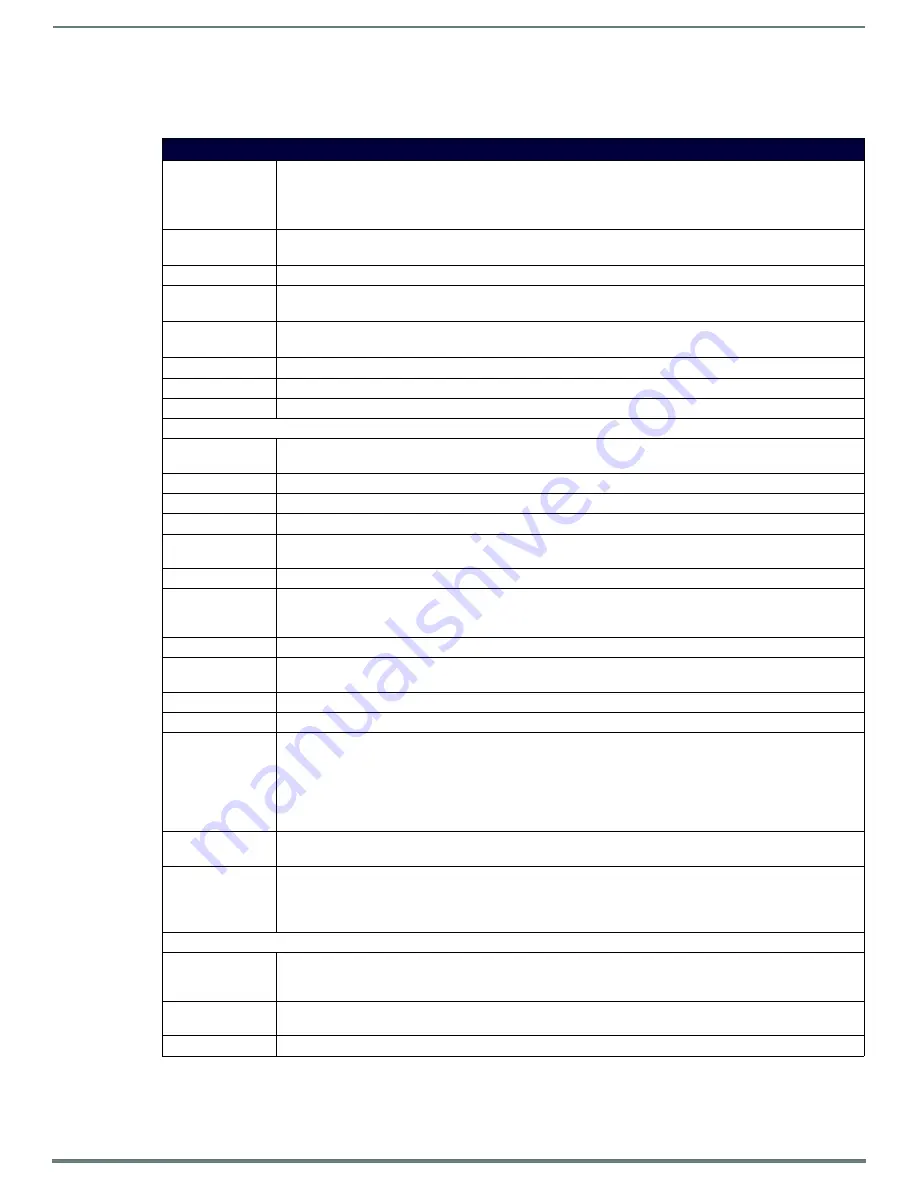
Introduction
7
NI-2100/3100/4100 - Hardware Reference Guide
NOTE:
Verify you are using the latest NI firmware for the on-board Master. Verify you are using the latest version of NetLinx Studio
(available for download from www.amx.com).
NI-2100 Specifications
NI-2100 Specifications
Models Available:
•
NI-2100
64MB Controller (FG2105-04)
The NI-2100 can be upgraded to provide one ICSHub and two ICSNet ports by installing the optional ICSNet
daughter card (FG2105-10 - see
Other AMX Equipment
)
•
NI-2100/ICS
Controller with ICSNet (FG2105-14)
Dimensions (HWD):
• 3 1/2" x 17" x 3 1/2" (8.8 cm x 43.2 cm x 8.8 cm)
• RU: 2
Power Requirement: 700 mA @ 12 VDC
Memory:
• 64 MB SDRAM
• 1 MB Non-volatile (NV) SRAM
Compact Flash:
2GB or greater (upgradeable to 4GB - see
Other AMX Equipment
).
Note: AMX may increase Flash size at any time in response to market availability.
Weight:
4.50 lbs (2.04 kg)
Enclosure:
Metal with black matte finish
Certifications:
FCC Part 15 Class B, CE, and IEC 60950
Front Panel LEDs:
LINK/ACT
(green):
Blinks when the Ethernet cables are connected and terminated correctly. Also blinks when receiving Ethernet data
packets.
Status (green):
Blinks to indicate that the system is programmed and communicating properly.
Output (red):
Blinks when the Controller transmits data, sets channels On and Off, sends data strings, etc.
Input (yellow):
Blinks when the Controller receives data from button pushes, strings, commands, channel levels, etc.
RS-232/422/485
(red / yellow):
3 sets of LEDs light to indicate that DB9 Ports 1 - 3 are transmitting or receiving RS-232, 422, or 485 data
(red = TX, yellow = RX).
Relay (red):
4 LEDs light to indicate the relay channels 1 - 4 are active (closed). The LEDs reflect the state of the relay on Port 4.
IR/Serial (red):
4 LEDs light to indicate the IR/Serial channels 1 - 4 are transmitting control data on Ports 5 - 8. The LED indicator
for each IR port remains lit for the length of time that
IR/Serial data is being generated.
I/O (yellow):
Lights when the I/O channels 1 - 4 are active. The LED for each I/O port reflects the state of that particular port.
RS-232/422/485
(Ports 1 - 3):
3 RS-232/422/485 control ports using DB9 (male) connectors with XON/XOFF (transmit on/transmit off),
CTS/RTS (clear to send/ready to send), and 300-115,200 baud.
ICSNet:
2 RJ-45 connectors for ICSNet interface
(provided by optional ICSNet daughter card).
ICSHub Out:
RJ-45 connector provides data to a Hub connected to the Controller (provided by optional ICSNet daughter card).
Relay (Port 4):
• 4-channel single-pole single-throw relay ports
• Each relay is independently controlled.
• Supports up to 4 independent external relay devices
• Channel range = 1-4
• Each relay can switch up to 24 VDC or 28 VAC @ 1 A
• 8-pin 3.5 mm mini-Phoenix (female) connector provides relay termination
Digital I/O
(Port 9):
4-channel binary I/O port for contact closure with each input being capable of voltage sensing. Input format is
software selectable with interactive power sensing for IR ports.
IR/Serial
(Ports 5 - 8):
4 IR/Serial control ports support high-frequency carriers of up to 1.142 MHz with each output being capable of
two electrical formats: IR or Serial.
• 4 IR/Serial data signals can be generated simultaneously.
• IR ports support data mode (at limited baud rates and wiring distances).
Rear Panel Components:
Program Port:
RS-232 DB9 connector (male) can be connected to a DB9 port on a PC. This connector can be used with serial and
NetLinx programming commands, as well as other DB9 capable devices, to both upload/download information from
the NetLinx Studio program.
Configuration
DIP Switch:
Sets the communication parameters for the Program port (see
Baud Rate Settings
).
ID Pushbutton:
Sets the NetLinx ID (Device only) assignment for the device.






















